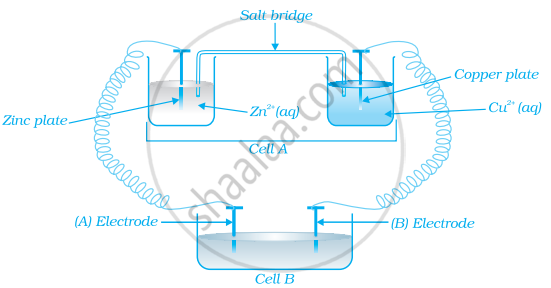Advertisements
Advertisements
Question
Draw a neat and well labelled diagram of primary reference electrode.
Solution
Primary reference electrode:

Standard Hydrogen Electrode
(Primary Reference Electrode)
APPEARS IN
RELATED QUESTIONS
Can copper sulphate solution be stored in an iron vessel? Explain.
Calculate E°cell for the following reaction at 298 K:
2Al(s) + 3Cu+2(0.01M) → 2Al+3(0.01M) + 3Cu(s)
Given: Ecell = 1.98V
Calculate emf of the following cell at 25°C:
\[\ce{Sn/Sn^2+ (0.001 M) || H+ (0.01 M) | H2_{(g)} (1 bar) | Pt_{(s)}}\]
Given: \[\ce{E^\circ(Sn^2+/sn) = -0.14 V, E^\circ H+/H2 = 0.00 V (log 10 = 1)}\]
Calculate e.m.f of the following cell at 298 K:
2Cr(s) + 3Fe2+ (0.1M) → 2Cr3+ (0.01M) + 3 Fe(s)
Given: E°(Cr3+ | Cr) = – 0.74 VE° (Fe2+ | Fe) = – 0.44 V
Calculate emf of the following cell at 25 °C :
Fe|Fe2+(0.001 M)| |H+(0.01 M)|H2(g) (1 bar)|Pt (s)
E°(Fe2+| Fe)= −0.44 V E°(H+ | H2) = 0.00 V
Depict the galvanic cell in which the reaction \[\ce{Zn(s) + 2Ag+(aq) → Zn^{2+}(aq) + 2Ag(s)}\] takes place. Further show:
- Which of the electrode is negatively charged?
- The carriers of the current in the cell.
- Individual reaction at each electrode.
Draw a neat and labelled diagram of the lead storage battery.
Calculate the emf of the following cell at 25°C :
Galvanic or a voltaic cell converts the chemical energy liberated during a redox reaction to ____________.
Standard electrode potential is measured taking the concentrations of all the species involved in a half-cell is ____________.
Standard hydrogen electrode operated under standard conditions of 1 atm H2 pressure, 298 K, and pH = 0 has a cell potential of ____________.
Which cell will measure standard electrode potential of copper electrode?
The difference between the electrode potentials of two electrodes when no current is drawn through the cell is called ______.
Using the data given below find out the strongest reducing agent.
`"E"_("Cr"_2"O"_7^(2-)//"Cr"^(3+))^⊖` = 1.33 V `"E"_("Cl"_2//"Cl"^-) = 1.36` V
`"E"_("MnO"_4^-//"Mn"^(2+))` = 1.51 V `"E"_("Cr"^(3+)//"Cr")` = - 0.74 V
Which reference electrode is used to measure the electrode potential of other electrodes?
Assertion: Cu is less reactive than hydrogen.
Reason: `E_((Cu^(2+))/(Cu))^Θ` is negative.
Consider the figure and answer the following question.
If cell ‘A’ has ECell = 0.5V and cell ‘B’ has ECell = 1.1V then what will be the reactions at anode and cathode?
Represent the cell in which the following reaction takes place.The value of E˚ for the cell is 1.260 V. What is the value of Ecell?
\[\ce{2Al (s) + 3Cd^{2+} (0.1M) -> 3Cd (s) + 2Al^{3+} (0.01M)}\]
The standard electrode potential of the two half cells are given below:
\[\ce{Ni^{2+} + 2e^{-} -> Ni, E_0 = - 0.25 Volt}\]
\[\ce{Zn^{2+} + 2e^{-} -> Zn, E_0 = - 0.77 Volt}\]
The voltage of cell formed by combining the two half cells would be?
Which is the correct order of second ionization potential of C, N, O and F in the following?
Standard electrode potential of three metals X, Y and Z are – 1.2 V, + 0.5 V and – 3.0 V, respectively. The reducing power of these metals will be:
Standard reduction potentials (E°) of Cd2+, respectively which is the strongest reducing agent
The emf of a galvanic cell, with electrode potential of Zn2+ = - 0.76 V and that of Cu2+ = 0.34 V, is ______.
A voltaic cell is made by connecting two half cells represented by half equations below:
\[\ce{Sn^{2+}_{ (aq)} + 2e^- -> Sn_{(s)}}\], E0 = − 0.14 V
\[\ce{Fe^{3+}_{ (aq)} + e^- -> Fe^{2+}_{ (aq)}}\], E0 = + 0.77 V
Which statement is correct about this voltaic cell?
